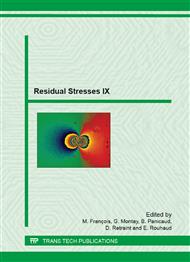p.295
p.301
p.307
p.313
p.319
p.325
p.331
p.337
p.343
Four-Point Bending Tests to Study the So-Called Plasticity Effect on the Residual Stress Results Determined by the Hole-Drilling and Ring-Core Methods
Abstract:
The hole-drilling method (HDM) and ring core method (RCM) are limited to low residual stresses under 60% of the yield stress. This issue will experimentally analyze the method of adaptive calculation function, presented by the author on the ICRS9. With a four-point-bending test machine, a defined stress can be triggered between the middle bending. In this defined loading area, the strains in two load cases with the HDM and the RCM configuration were measured. With these measured strains the residual stress calculation will be analysed.
Info:
Periodical:
Pages:
319-324
Citation:
Online since:
August 2014
Authors:
Permissions:
Share:
Citation:


